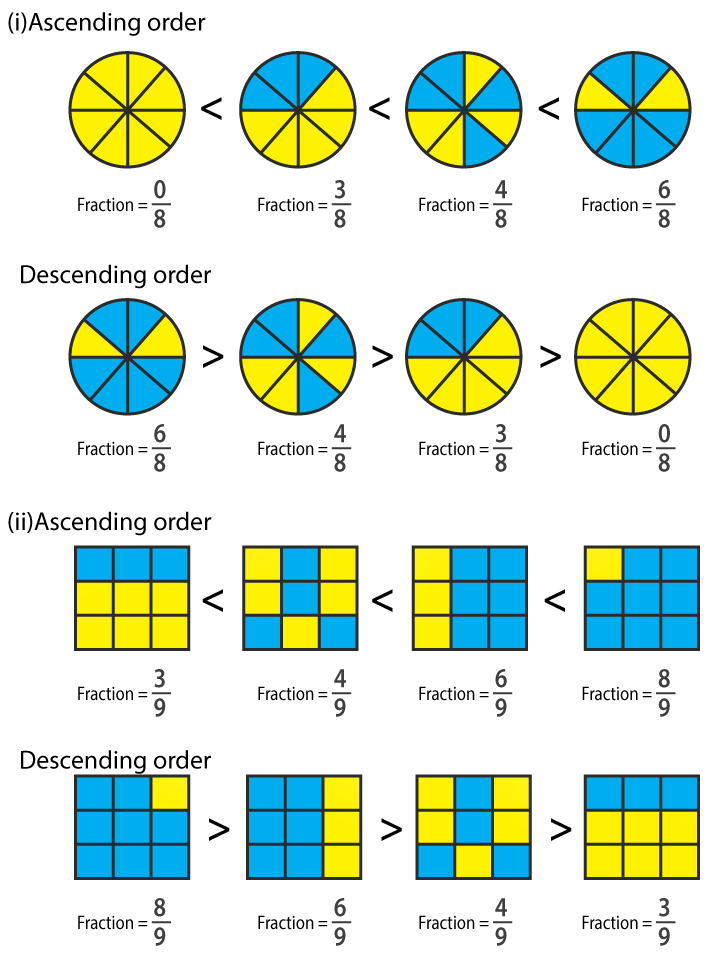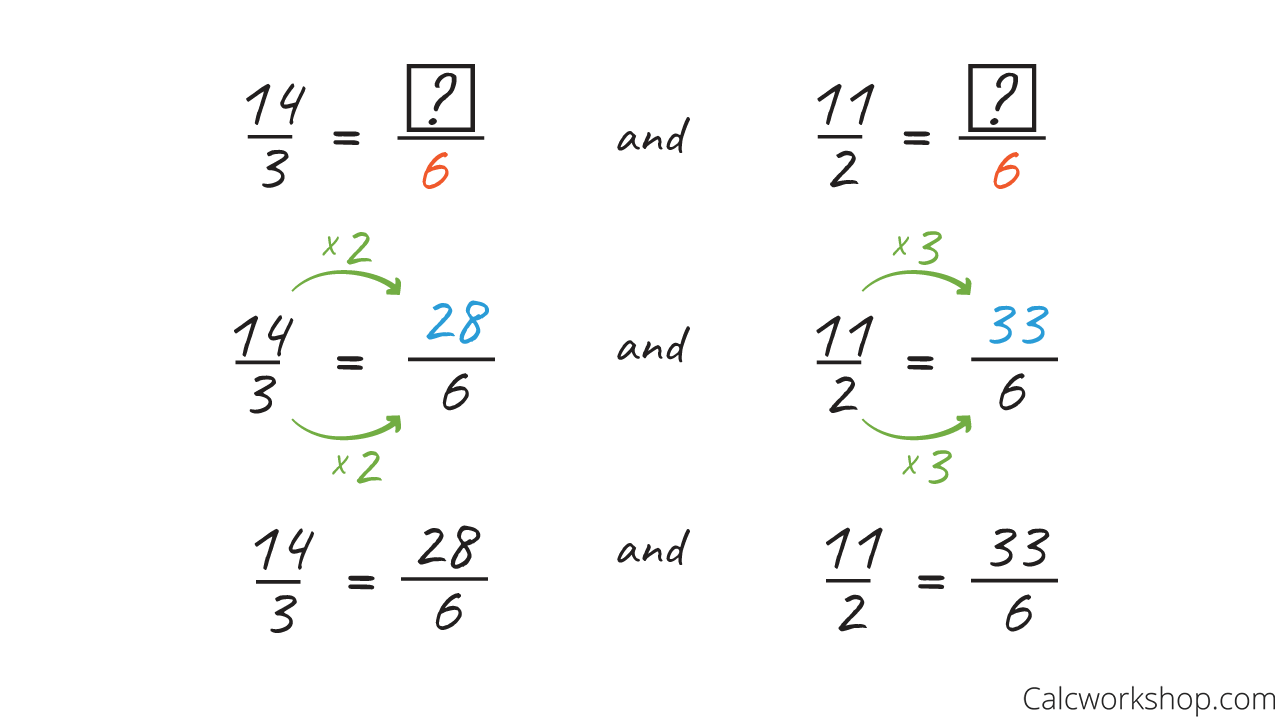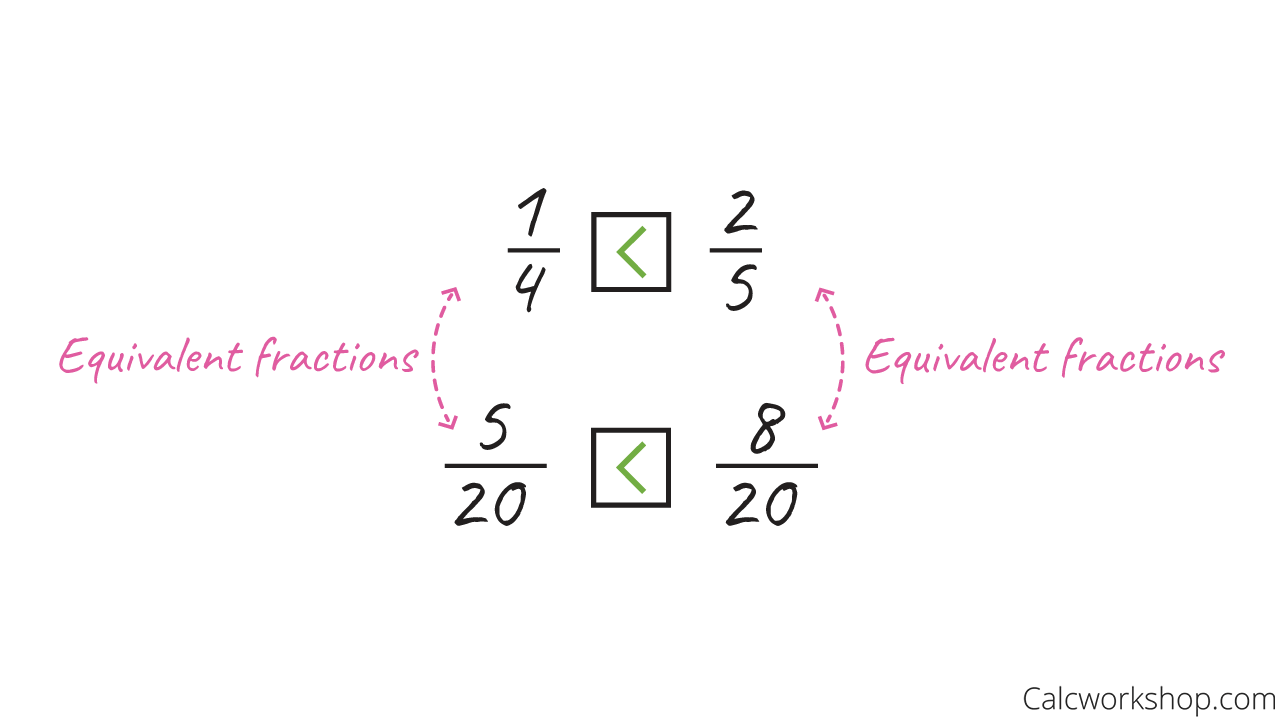40 using a common denominator to order fractions
How Do You Compare Fractions by Finding a Common Denominator? Find a common denominator by multiplying the denominators together. Use that common denominator to create equivalent fractions. Then, compare the numerators to figure out which is bigger! This tutorial shows you how! Keywords: problem denominator common denominator compare fractions fraction different denominators equivalent fractions numerators Ordering Fractions Calculator: Ascending, Descending ... To convert fractions to like denominators, start by finding the least common denominator (LCD) of all denominators (lowest number all 5 denominators divide into evenly), which in this case is 2520. Next, for each fraction, divide the LCM by the denominator and then multiply that result by the numerator to get the converted numerator.
Ordering Fractions Calculator To compare and order fractions we must first convert all integers, mixed numbers (mixed fractions) and fractions into values that we can compare. We do this by first converting all terms into fractions, finding the least common denominator ( LCD ), then rewriting each term as an equivalent fraction with the LCD.

Using a common denominator to order fractions
Using a Common Denominator to Order Fractions - Study.com To order a set of fractions from smallest to largest, first rewrite all of the fractions with a common denominator. Then, the fractions can be ordered by examining the numerators - the smallest... How to Square Fractions: 12 Steps (with Pictures) - wikiHow 29.03.2019 · Check to see if you can simplify the fraction before you square it. It is usually easier to reduce fractions before squaring them. Remember, to reduce a fraction means to divide it by a common factor until the number one is the only number that can be evenly divided into both the numerator and denominator. Reducing the fraction first means you don’t have to reduce it at … Common Denominator - Math is Fun Before we can add or subtract fractions, the fractions need to have a common denominator. In other words the denominators must be the same. Making The Denominators the Same. To make the denominators the same we can: Multiply top and bottom of each fraction by the denominator of the other. Like in this example (press play button):
Using a common denominator to order fractions. How Do You Put Fractions in Order Using an LCD? - Virtual Nerd You could find the least common denominator (LCD) of the fractions and write equivalent fractions with this LCD. Then, compare the numerators to figure out their order from least to greatest! This tutorial shows you how! Keywords: problem fraction fractions order order fractions denominator common denominator least common denominator lcd Ordering Fractions - Explanation & Examples Fractions can be compared and ordered by determining their equivalent fractions with the common denominator. Common denominators are created by using common multiples of the two numbers. For example, 24 is the least common multiple of 8 and 12. 8 x 3 = 24 12 x 2 = 24 Yet 8 and 12 have several other common multiples; however, 24 is the lowest. Comparing and ordering fractions (video) | Khan Academy What I want to do in this video is order these fractions from least to greatest. And the easiest way and the way that I think we can be sure we'll get the right answer here is to find a common denominator, because if we don't find a common denominator, these fractions are really hard to compare. 4/9 versus 3/4 versus 4/5, 11/12, 13/15. 4 common fractions misconceptions and how to address them 22.03.2021 · Common misconception 1: not understanding the denominator. A common misconception is that learners believe the numerator and denominator are the same. Let’s start with the fractions basics to help address this misconception. ‘Denominator’ means ‘that which names’ in Latin. This translation identifies the denominator as a name the same ...
Multiplying Fractions By Cancelling Common Factors - Math … Example 2: Multiply by dividing out common factors. Analysis: Divide 15 into 15.Divide 2 into 14 and 16. Solution: The following is the procedure for multiplying fractions with cancelling of factors. Procedure: To multiply fractions by cancelling common factors, divide out factors that are common to both a numerator and a denominator.The factor being divided out can appear … Ordering Fractions Calculator | iCalculator™ How to Order Fractions from Least to Greatest. Enter your fractions into the Ordering Fractions Calculator. Fractions can be entered by typing the Numerator (top number of the fraction), then a forward slash (a forward slash is used to represent the Vinculem) and finally the Denominator (bottom number of a fraction). Easy Step-by-Step Guide on How to Order Fractions How To Order Fractions Candice 09/09/21 Step 1: Find the least common denominators Given a set of fractions with unlike denominators, find the least common denominator (LCD) shared by the fractions. So, if we want to arrange 1/35, 3/7, 7/10, 4/5 and 12/35 from greatest to least, let's determine the LCD shared by the fractions first. Ordering Fractions | Math Goodies To order fractions with like numerators, look at the denominators and compare them two at a time. The fraction with the smaller denominator is the larger fraction. Let's look at another example. In example 7, we did not find the LCD. If we had, then it would be difficult to name a fraction between one-fourth and two-fourths.
Common Denominator Calculator - math-physics-calc.com The calculator can make the denominator common to two, three and four fractions and give you a detailed step-by-step solution. Notice We and selected partners use cookies or similar technologies as specified in the cookie policy . How to Order Fractions From Least to Greatest - UpSkillMe How to Order Fractions using Common Denominator. Identify all the denominators of the fractions. Calculate the least common multiple of all the denominators. Rewrite each fraction as an equivalent fraction with the denominator. Place the fractions in ascending order by comparing their numerators. For Example, Comparing Fractions - Math is Fun There are two main ways to compare fractions: using decimals, or using the same denominator. The Decimal Method of Comparing Fractions. Convert each fraction to decimals, and then compare the decimals. Example: which is bigger: 3 8 or 5 12 ? Convert each fraction to a decimal. We can use a calculator (3÷8 and 5÷12), or the method on Converting Fractions to … Dividing fractions by using a common denominator Dividing fractions by using a common denominator. ... subtracting Normal distribution nth term rule Operations with surds Ordering decimals Ordering fractions Ordering negative numbers Order of operations Parallel lines Parallel vectors Parts of a circle Percentage change Percentage decrease Percentage increase Percentage of an amount ...
3 Ways to Order Fractions From Least to Greatest - wikiHow Try it for 2/3, 5/6, and 1/3, using the common denominator 18: 18 ÷ 3 = 6, so 2/3 = (2x6)/ (3x6)=12/18 18 ÷ 6 = 3, so 5/6 = (5x3)/ (6x3)=15/18 18 ÷ 3 = 6, so 1/3 = (1x6)/ (3x6)=6/18 3 Use the top number to order the fractions. Now that they all have the same denominator, the fractions are easy to compare.
Using a Common Denominator to Order Fraction - Tutorialspoint Ordering fractions is arranging them either in increasing or decreasing order. The fractions that are to be ordered can have like or unlike denominators. Formula. In case we are required to order fractions with unlike denominators, we write their equivalent fractions with like denominators after finding their least common denominator. Then we ...
Common Denominator (LCD) Calculator In order to find the LCD, firstly we convert all integers and mixed fractions into fractions. Then we find the LCM of the denominators. The result is the LCD and each fraction should be written as an equivalent fraction with the same LCD. In some problems it is required to evaluate algebraic expressions. These problems can be solved by finding the least common denominator of two …
Using a common denominator to order fractions - YouTube How to order fractions by finding a common denominator. How to order fractions by finding a common denominator.
Finding Common Denominators In order to add fractions, the denominators must be the same. In the example of pizza, this means each slice has to be the same size. If we are working with pizza slices that have been cut into different sizes, we need to find a way to cut all of them into slices that are the same size. This is done using Least Common Multiples.
Learn about ordering fractions - KS3 Maths - BBC Bitesize ... To order fractions with different denominators and numerators, the denominators have to be the same. To do this: Find the lowest common multiple of the denominators. This will be the denominator of...
Least Common Denominator - Worksheets Adding Fractions. Practice using LCD to add fractions with unlike denominators. Subtracting Fractions. Subtract fractions and mixed numbers with unlike denominators. Least Common Multiples (LCM) Finding the Least Common Multiple (LCM) is very a similar skill to finding Least Common Denominator (LCD).
Ordering fractions (video) | Fractions | Khan Academy Six times five equals 30, so yes. 30 can work to be our common denominator. 30ths, 30 is a multiple of 10, three, and six. So let's start converting our fractions to have denominators of 30. We'll start with 7/10, and we want it to have a denominator of 30, so what do we need to multiply by? 10 times three is 30.
Ordering Fractions Calculator • 3/4, 9/12 and -12/16 are proper fractions so we can use those as they are written • 2 in fraction form is 2/1 • Convert 3 5/8 to an improper fraction. Multiply the whole number 3 by the denominator 8 to get 24. Add 24 to the numerator 5 to get 29/8. So 3 5/8 = 29/8. • All inputs as fractions: 2/1, 3/4, 9/12, 29/8, -12/16
Least Common Denominator (LCD) Calculator - Symbolab Free Least Common Denominator (LCD) calculator - Find the LCD of two or more numbers step-by-step This website uses cookies to ensure you get the best experience. By using this website, you agree to our Cookie Policy.
How to Create Equivalent Fractions Using Common Denominators You must find a common denominator if you want to add, subtract, or compare fractions that have different denominators. A common denominator, which means having the same number in the denominator (or the bottom) of each fraction, creates equivalent fractions that can be added, subtracted, or compared. Finding a common denominator means finding one number that each denominator can ...
Free worksheets for comparing or ordering fractions Initially, students learn to compare fractions that have the same denominator (such as 5/12 and 9/12) and fractions with the same numerator (such as 5/9 and 5/7). They also learn to compare to 1/2 (such as 1/2 and 4/5). In grade 5, students learn how to compare any two fractions by first converting them so they have a common denominator.
Ordering fractions - Fractions - AQA - GCSE Maths Revision ... Ordering fractions using common denominators Fractions can be compared by finding equivalent fractions with the same denominator. Common denominators are made using common multiples of the two...
Ordering Fractions With Different Denominators ORDERING FRACTIONS WITH DIFFERENT DENOMINATORS. The following steps would be useful to order fractions from least to greatest or greatest to least. Step 1 : Find the least common multiple of the denominators. Step 2 : Make the denominators of all the fractions same using the least common multiple. Step 3 :
Using Common Denominators to Order Fractions - YouTube About Press Copyright Contact us Creators Advertise Developers Terms Privacy Policy & Safety How YouTube works Test new features Press Copyright Contact us Creators ...
Using a Common Denominator to Order Fraction: Worksheets Using a Common Denominator to Order Fraction: Worksheets. Welcome to the Equivalent, Plotting and Ordering Fractions section at Tutorialspoint.com. On this page, you will find worksheets on definition of fractions, understanding of equivalent fractions, finding equivalent fractions of given fractions, simplification of fractions and reducing ...













0 Response to "40 using a common denominator to order fractions"
Post a Comment